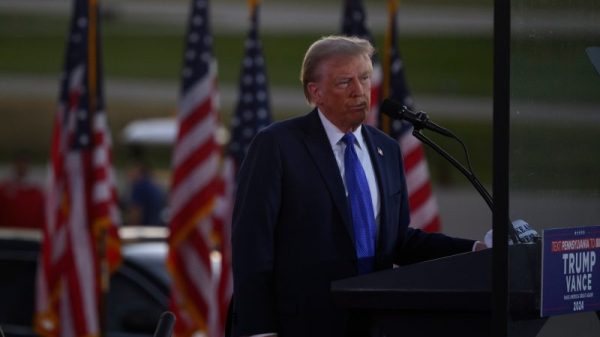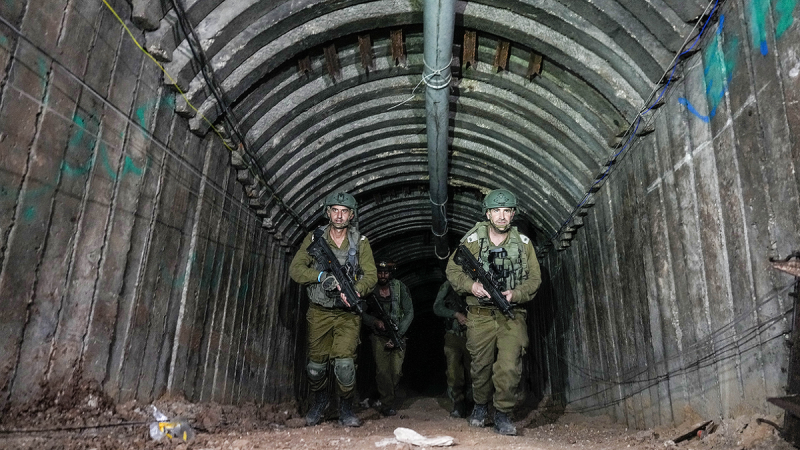JERUSALEM — For the past three months, almost on a daily basis, Israeli ground troops fighting inside the war-weary Gaza Strip have been sending missives and images of tunnel shafts or underground complexes, including weapons dispensaries or bunkers, discovered beneath homes, schools, mosques and hospitals.
In some cases, the tunnels are simple warrens enabling Hamas fighters to ambush Israeli soldiers; in others, the shafts are vast, elaborate creations replete with elevators, electricity and full ventilation systems.
Some are even equipped with bedrooms, bathrooms and dining rooms, as well as command centers for Hamas to carry out its ongoing military operation against Israel. In one of those command centers, the IDF uncovered a video of Hamas’ Southern Brigade Commander, Mohammed Sinwar, brother of the group’s top leader in Gaza, Yahya Sinwar, driving a car through a broad underground passage.
According to Israeli military estimates shared with Fox News Digital, Hamas, the Islamic terror group that sparked the war with Israel, has spent tens of millions of dollars — and the last 16 years as it governed Gaza — designing, digging and cementing an entire subterranean system rivaling London’s Underground or Paris’s Metro.
A report sent by IDF troops Thursday said it was likely Hamas ‘used more than 6,000 tons of concrete and 1,800 tons of metal to build hundreds of miles of underground infrastructure.’
While the existence of what Israelis refer to as the ‘Gaza Metro,’ which Palestinians call ‘Lower Gaza,’ has been well known about for years, with Hamas leaders even boasting about it, the question remains how, in one of the world’s most poverty-stricken territories, which relies largely on aid from U.N. agencies, regional and Western powers, the terror group had the financial means to invest in such an intricate and expansive terror tunnel network.
‘I don’t know if anybody knows exactly how much money Hamas spent on building this tunnel system,’ Nitsana Darshan-Leitner, president of Shurat HaDin, the Israel Law Center, told Fox News Digital.
Darshan-Leitner, whose 2017 book ‘Harpoon’ takes a deep dive into how terror groups, including Hamas, find their funding, said she did not believe that at this stage even the IDF understands the extent of Hamas’ underground metropolis.
‘Every day they are surprised to find another tunnel; they are surprised by its length, its complexity, how many floors it has, how wide it is. I don’t think they have the whole picture yet,’ she said.
She added that building such an elaborate system would likely have cost ‘tens of millions of dollars, if not more. The question is where did the money come from?’
As the governing body in Gaza, Darshan-Leitner said a large bulk of Hamas’ funds were levied from the Strip’s 2.2 million residents via ordinary taxes, even as aid agencies such as the U.N. agency for Palestinian refugees, UNRWA; the Palestinian Authority, which governs Palestinians in the West Bank; and regional powers like Qatar provided crucial humanitarian services or built key infrastructure projects in the coastal enclave.
‘Hamas took taxes from its residents and let others pay for everything that, as a government, it was supposed to take care of,’ Darshan-Leitner said. She described how for most of the past two decades, Qatar supplied oil and funded humanitarian projects, the PA covered the costs of electricity, water, health and education, while UNRWA – including with funding from the U.S. – took care of a wide variety of needs for some 75% of the population considered refugees.
‘Hamas does not need to pay a dime for the population. Everything is taking care of by others,’ she said. ‘This allows them to use their money for military purposes.’
Juliette Touma, director of communications for UNRWA, told Fox News Digital the agency had no knowledge that its activities, which she said were mandated by the U.N. General Assembly, enabled Hamas the freedom to build the tunnels.
‘We are a humanitarian United Nations agency,’ she said. ‘We provide, through UNRWA staff, screened and scrutinized humanitarian assistance to people. There is no third party.’
However, Hamas leaders have admitted to taking advantage of the fact that the U.N. and others care for the civilians to build a vast tunnel network beneath the enclave. In a recent interview, Qatari-based Hamas leader Moussa Abu Marzouk said the reason Hamas built no bomb shelters for Gaza’s population — only tunnels for Hamas fighters to hide and fight — was because it was the U.N.’s responsibility to ‘protect’ the majority of Gaza’s population.
Funding the tunnel project from inflated taxation and minimal governing responsibility, however, forms just a small portion of Hamas’ terror income, Dr. Ronnie Shaked, a researcher on Palestinian Affairs at the Truman Institute at Hebrew University, told Fox News Digital.
He said the U.S-designated terror group, like other Islamic organizations in the region, was closely aligned with Iran and clandestinely received millions of dollars a year, as well as weapons and military training from Tehran.
‘It is all part of an Iranian doctrine,’ said Shaked, a former senior correspondent and commentator on Palestinian Affairs for the popular Hebrew daily Yedioth Aharanoth and author of a book studying the rise of Hamas within Palestinian society.
He said Hamas had not only invested billions of dollars in building the tunnels but also devoted a huge amount of manpower and effort to create an underground city, where the top Hamas leaders have been hiding for most of the past 100 days.
‘In order to create a tunnel that is around 400 km (250 miles) over 15 years, then you need millions of dollars. You also need tools and tens of thousands of workers to dig and find ways to remove all the sand and dust from inside the tunnels,’ he said. ‘Then there’s the electrical system, ventilation system and special machinery needed to build it all.’
Shaked said designing such tunnels and mapping them out in a coastal territory like the Gaza Strip would also have required top-notch engineers who could contend with the unique topography and proximity to the sea, as well as designers mapping out complex routes beneath the densely populated enclave.
According to the former journalist, Hamas’ tunnel project began in the early 2000s with underground passageways used to smuggle goods from Egypt into the enclave. The terror group quickly moved on to attack tunnels snaking beneath the border with Israel, which were used most notably in 2006 when Israeli soldier Gilad Shalit was attacked and kidnapped back to Gaza. At that same time, Hamas also started creating its complex network of tunnels beneath the homes, schools and medical centers of its own people.
While a large part of the covert funding came from Iran, Shaked also noted that, over the years, Qatar was also directly involved in sending millions of dollars into the Gaza Strip. In the early days, much of the funding arrived in cash-filled suitcases, first smuggled into Gaza via Egypt. But, later, after a special Mossad unit tasked with tracking and thwarting the flow of money to Hamas was disbanded, it arrived as part of a special arrangement with Israel.
Beginning in 2018, Qatar’s Special Envoy to Gaza, Mohammed Al Emadi, was permitted to enter the Strip and hand-deliver millions of dollars in cash meant for humanitarian projects. Now, it appears that money too went straight into the hands of Hamas.
‘In recent years, instead of fighting the terror financing, Israel began to allow money to flow into Gaza, including enabling Qatar to give the cash straight to Hamas,’ Darshan-Leitner said. She described an official Israeli policy aimed at keeping the Palestinian leadership — Hamas in Gaza and the PA in the West Bank — divided and therefore preventing the creation of a cohesive Palestinian state.
‘Israel also thought that if they gave money to Hamas and if they allowed Palestinians workers to enter Israel — if they allowed the people in Gaza just a little bit better quality of life — then they would have no reason to terrorize Israel,’ she said.
That plan backfired Oct. 7 when thousands of highly trained Hamas terrorists stormed across the border massacring some 1,200 Israelis on army bases, in their homes and at a music festival in the area. That attack initiated the current war, and now Israeli forces are working hard to dismantle Hamas’ underground terror threat and locate more than 130 Israeli nationals who it believes are being held hostage in the tunnels.
Brig. Gen. (Retired) Yaakov Nagel, Israel’s former acting national security adviser and now a senior research fellow at the Foundation for the Defense of Democracies, said Hamas built ‘a full city beneath a city.’
‘We knew about the tunnels, but we didn’t know the width, the depth or the length of them,’ he said. ‘People estimated there was about 200 kilometers [125 miles], but it now looks like there’s thousands of kilometers.
‘In some places, there are three layers of tunnels. And in other places it is wide enough to drive a jeep,’ Nagel said. He noted it was clear a large chunk of the Qatari money meant to help Gaza civilians rebuild the strip following a previous round of fighting in 2014 ‘went to the terrorist group’s programs, its tunnels, its missiles, its weapons production sites and into the pockets of corrupt leaders.’
Before Oct. 7, he said, the military’s focus was only on destroying the tunnels that crossed the border into Israeli territory. Following the 2014 war — and mass border protests in Gaza in 2018 — Israel ramped up its border defense system, investing $1 billion on an underground barrier to block those tunnels and develop new intelligence technology above ground to monitor what was happening on the other side.
‘Unfortunately, we now know it was a mistake because it pushed them to attack the weakest part of our defense, the one that relied solely on technology,’ said Nagel. ‘We had the intelligence, but we did not fully understand or digest it. So, when 3,000 terrorists forced their way into Israel in 33 places along the border using heavy machinery, there were not enough people on our side of the border to physically stop them.’
The surprise attack and now the surprises that the Israeli military is revealing inside Gaza are among the reasons, he said, that Israel is pushing for greater control of the Strip once the war is over.
‘What we are dealing with now is so big, and it will be a lot of work to dismantle it all,’ Nagel said. ‘If Israel is not inside in the future, then it can’t control what is happening. And that is why Israel favors having greater control over Gaza the day after the war — so we don’t encounter any more surprises.’







































